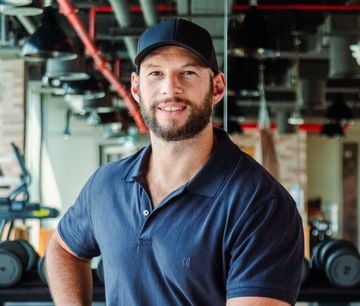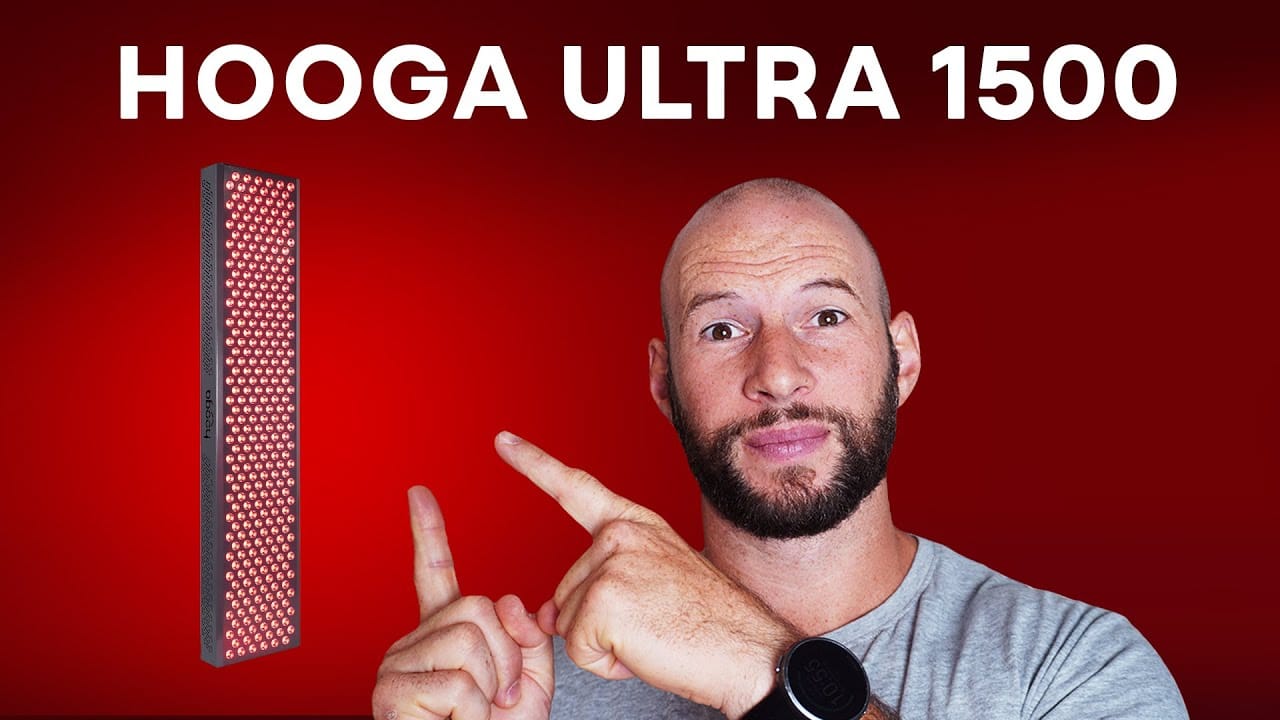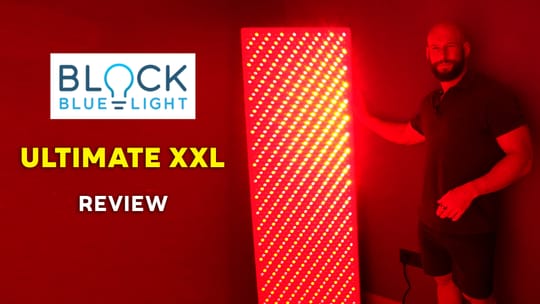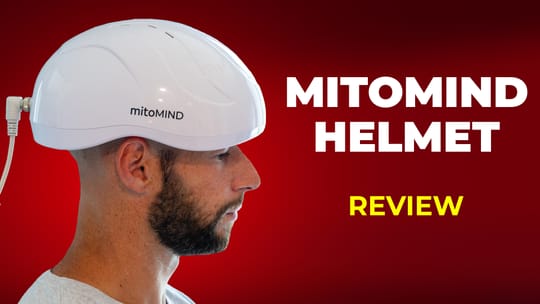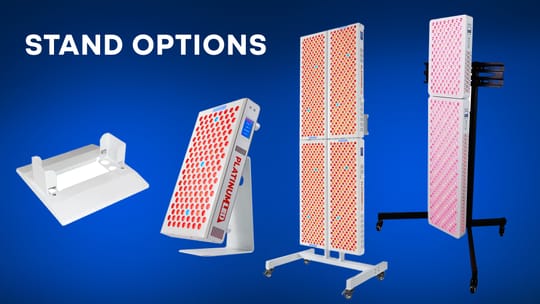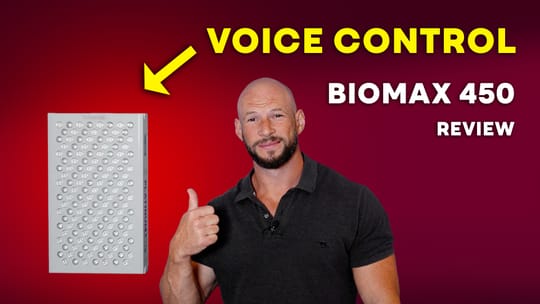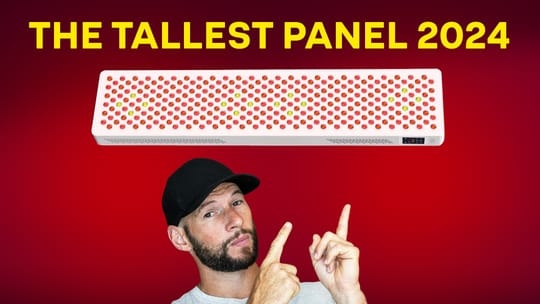Welcome to the bright side! Hooga Health is well known for offering great value, low-cost, red light therapy products. This full body wall panel is a trend setter with innovative features not seen in previous Hooga panels while remaining competitively priced.

I'm impressed with its 300 LED lens bulbs and four chips in each one for a whopping 1200 diodes in all generating a balanced blend of beneficial light. You'll be glad to know, 25% of its power is going to the highly desirable 810nm wavelength. In light of these highlights, Hooga Ultra 1500 (discount code ALEX saves) is ready to revolutionize your red light therapy sessions!
Introducing Hooga's Ultra Premium Line
There's more to this panel than meets the eye, so let's dive into the brilliance of this premium panel. Hooga Ultra1500 is a beacon of beneficial light in Hooga's premium product line called Ultra.

Additionally, this premium Ultra line offers two smaller panel options, including Ultra360 with 72 LEDs for $399, Ultra750 with 150 LEDs for $799, plus the Ultra5400 for $4500 which is a massive 1000 LED panel. Wouldn't we all love to have one of those!

As you can see from this Hooga website image, the company doesn't use a space between the name of the line in all capital letters and the panel number. Therefore, the most accurate nomenclature is ULTRA1500. Throughout this article, you will see me refer to the panel as Ultra 1500 simply because I like it that way.
Ultra Line Features that Spark Interest
- the ability to adjust intensity or brightness
- the option to pulse the near infrared at 10 Hz pulsing
- an improved control panel which is very nice although not a touch-screen
- modular capabilities to connect multiple Ultra panels together
A Balanced Spectrum of Benefits
Let's get down to the nitty-gritty science behind the glow. The Ultra 1500 harnesses the power of quad-chip LEDs. Each little bulb you see has four little chips inside it that are emitting four different wavelengths (630, 660, 810, and 850nm) for a beneficial blend of light to help support your health goals.

My tests confirmed the emission of these four wavelengths, ensuring a comprehensive therapeutic spectrum that includes 810nm light. If you are interested in learning more about why I think it is particularly helpful, I'll share a link at the end of this article to a helpful resource on my website Light Therapy Insiders: "810 Nanometer Wavelength Health Benefits/Effects Cheatsheet"

Some competitor's panels may only offer single chip technology. With those classic yet old school LEDs, you get one wavelength per LED so it is all spread out. You will get a nice even blend of therapeutic light and better coverage with these high tech quadruple chip LEDs.

If you tend to stand in the same spot in front of the panel day after day, quad-chip lens LEDs ensure that you don't have spotty coverage. I like this feature because we are every bulb bathes us in a beneficial blend of therapeutic light.
Putting it to the Test
Numbers don't lie—but sometimes, they can be a bit cheeky. While the Ultra 1500 shines extra bright with its impressive quad-chip technology that soars above the competition, there were a few bumps in the road due to power output discrepancies.
Hooga's website says the power output is greater than 165mW/cm² at 6 inches. However, Hooga's manual says it has 100mW/cm² at 6 inches. Also, it says the power output is 165mW/cm² on another page. There is nothing saying how they calculated their figures, so their published information is confusing.

Considering how high it is, they must be using a solar-meter for measuring sunlight which is not designed for this purpose. Solar-meter figures always seem to be roughly 200% above what my LED spectrometer results show.
I really wish all companies would use more accurate measurement tools or send their products off for third party independent testing. I hope all companies will stop using solar-meter readings completely.
The greatest discrepancy I have found so far is that the Infraredi website says: "All three feature irradiance over 212 mW/cm2, considerably higher than most red light products that usually range from 30-133 mW/cm2."

Yet that advertized irradiance of over 212 mW/cm2 is 296% higher than my spectrometer measurements of 72mW/cm² in testing their Infraredi Pro Max panel for my 2024 Comparison Series. As you can see in the screenshot, that is a decent amount of power earning them 8th place in the Power Round which put them right in the middle of the pack among all 17 panels I tested.
Beyond the shadow of a doubt, the best tool for measuring LED light is a spectrometer like the one I use. It cost me a few thousand dollars, but it's well worth it because it is more accurate for this type of light. It is noteworthy that both my average and my peak power readings were significantly lower than those published by Hooga.

Despite this, the Ultra 1500 still delivers a substantial amount of therapeutic red light. Hooga Ultra 1500 (remember code ALEX saves) performed well in terms of irradiance earning 4th place in the Power Round among the 17 panels in my 2024 Comparison Series.
Oddly, Hooga's site lists a total power metric of 460 some watts. I have no idea how they arrived at that figure, but it is nowhere near my calculations. Ideally, each company would also send their panels off for independent 3rd party testing and transparently share that data with their customers.

At the very least, it would sure be better if all companies would label their readings as solar-meter or spectrometer readings to eliminate needless confusion. This is why I do my own calculations and comparisons and share my findings freely with handy tools I have created for my community such as my Shopping Tool shown here.

Again, the power irradiance figures according to my spectrometer are still really high. It is interesting though that as I moved away from the vertical midline, the power did drop right off rather sharply.
I was seeing power peaks in the high 90s and even 100mW/cm² concentrated in the center of the panel. But on the edges, it dropped right down to about 60mW/cm² which is to be expected due to how narrow it is.

When I test wider 12 or 15 inch panels, I do see a more stable level of power across the board. Still though, it is putting out a heap of therapeutic red and near infrared light.
If for any reason you want less light, you can easily stand a bit further from the panel or use the dimmer feature on the control panel to dial it down for those who want to do so.

Evaluating Its Premium Features
Speaking of the control panel, I really like the feel of this one because the buttons are nice to press, the feedback is instantaneous, the icons just make sense, and overall it works really well.

The high contrast design of this white and green LED display is easier for me to see than some competitors that may use lower contrast colors. This high contrast is especially important when the powerfully bright therapeutic LEDs on the front face of the panel are running.
It's not a high resolution, high tech control panel of some of its competitors. Overall, this control panel simply works really well for me considering the context of the panel's capabilities and objectives.

The face of the panel has a really nice smooth charcoal grey finish which gives it more of a premium feel especially compared to the other budget-conscious Hooga lines that I have also reviewed. The branding looks good too.

It comes with a nice carry hold grip place at the top of the panel to make moving it easier. It also included all the key accessories.
This is a legit company that has been around for years with hundreds of products. Rest assured, you're going to get the support and care you deserve when making a large investment in your health by getting a large premium panel.
There was an EMF (electric and magnetic fields) reading of 0.2 of a microtesla (μT) at 6 inches which is a low orange which is nothing concerning. It is higher than most of the newest panels I'm testing, but it is still what I consider to be safe.
Price Tag Wisdom
Now, let's talk dollars and cents and sensibility since the Ultra 1500 may seem like a splurge, but it's worth it considering it's cost value of only $9.10 per watt!
The Ultra stand retails for $399. Although, the website states that it is not designed for the narrower panels such as this one. You may be able to still use it, but this is one of the things we need to confirm with Hooga first.
If you're shipping across the pond, you might need to dip into your rainy day fund since international shipping runs around $100 to the UK or $200 to Australia.

When considering the price alongside the power output, Ultra 1500 ranks favorably in 8th place out of 17 panels with its $9.10 per watt cost since I have always said anything more affordable than $10 per watt is a great value! You may wonder why it's not ranking even higher, but that's because of the shape. If it were 12 or more inches across, it would be ranking even better.
HSA & FSA Payment Accounts Accepted
For those of you who have an HSA (Health Savings Account) or FSA (Flexible Spending Account), Hooga makes it convenient to buy their products with your pre-tax medical spending accounts.
There is a short HSA/FSA medical qualification questionnaire when you elect to pay with Truemed that asks if you: "Are working to mitigate, treat, or reverse a health condition such as depression, anxiety, chronic fatigue, insomnia, obesity, infertility, diabetes, or heart disease."

Hooga's site also explains that with Truemed HSA/FSA payments: "If you are eligible for HSA/FSA spending, you'll receive a Letter of Medical Necessity (LMN) several days after payment. To ensure compliance, keep that LMN and your receipts for the next three years (both should be in your email)."
The Shadow Side
Every hero has its Achilles' heel, and even the helpful Ultra 1500 has its pesky quirks: the high cost of international shipping, a lack of remote or app, the placement of the power cable is overly high which shortens the reach of the power cord, the limited dimming, and the single pulsing frequency which I don't mind, but I wanted to point it out for those that prioritize customizing the pulsing.
To me, one of the most significant drawbacks is the panel's narrow design at only 9 inches across. To recap, the issue with this was twofold: it had a sharp drop off in power down to only 60% near the edges and also you may need to treat one narrow area of your body at a time.

You may even need to treat an area such as your back one third at a time: left, right, and center. Yet that portion of your body is going to get a balanced blend of highly beneficial light.
My other significant concern is that Hooga's website and manual list very high power figures and their dosing figures in the manual are based on their surprisingly high power readings.
My measurements are nowhere near theirs, and they don't say how they got their numbers. Thus, their figures seem faulty to me. If those faulty figures are the foundation of their dosing protocols, those will be off as well.

Again, this is a common issue I am seeing in the red light therapy space. There are no real standards or rules regarding what type of meter should be used and what distance the measurements should be taken at, nor even how many readings should be taken to get an average rather than just a single peak.
I hope this will change in the coming years. In the meanwhile, I hope my reviews will be helpful to you with my standard testing methodology using the correct tool for the job of a spectrometer to measure LED light.
On The Bright Side
My calculations showed this is still a powerful panel which is one of the many factors that earned it 6th place overall among the 17 panels tested in my Comparison Series, so hats off to them for performing quite well!
Additional advantages: Hooga's good reputation, low cost per watt, sleek design, a classy color, 10Hz pulsing, dimming capability of 10%, 50%, and 100%, quad-chip LEDs with four different wavelengths, 25% of its power going to 810nm light, user-friendly control panel, quiet, low EMF, modular support, a 3-year warranty, a 60-day return period, possible HSA/FSA payment, and no restocking fee!
Head To Head Comparisons
How does Hooga's Ultra 1500 compare to their Pro 1500? The Ultra is $180 more since you are getting the 10Hz pulsing, quad-chip LEDs, four wavelengths, a much nicer control panel, modular support, and it is incredibly quiet for a panel of this size.

Ultra 1500 has a bit less power because of its shape and other factors, but at these high levels, that minor difference doesn't matter very much. My assessment is that Hooga's Ultra 1500 (code ALEX saves) is a better buy than their Pro 1500.
How does Hooga Ultra 1500 compare to PlatinumLED BioMax 900? That popular panel is one I use regularly. It costs a bit less, and it has done extremely well in my recent comparison series. It has a much nicer control panel, more stand options, it is wider at 12 inches which is very significant, and it has more wavelengths, including blue light.
However, most of the power is directed to the traditional 660 and 850nm wavelengths. It also doesn't have pulsing, and it only has single chip LEDs so some spots on your body may get less of a desired wavelength.
If you are looking for an even wider option, you may want to check out Mito Light Mitohacker 4.0. If you are looking for the widest body panel, look into the LightpathLED Diesel XL Shortie.
If you want a more affordable panel, check out the Mito Red Light MitoPro Series. I've reviewed all of these panels individually, and many more! I'm here to help you find the panel that's best for you.
Final Thoughts
As we wrap up our Hooga Ultra 1500 journey of discovery—wellness is an ongoing voyage towards pain relief, enhanced performance, and even quiet moments of relaxation as you bask in the glow of the Ultra 1500. So, here's to brighter days ahead with the Hooga Ultra 1500 illuminating your path forward.
This Article's Products With Benefits
✅ For Hooga Ultra1500 or Pro1500 click this link — discount code ALEX
✅ For PlatinumLED BioMax 900 by using this link for a discount — No discount code is available. Clicking my link generates your unique code.
✅ For Mito Light Mitohacker 4.0 click here — discount code ALEX
✅ For LightpathLED Shortie XL click here — discount code ALEX
✅ For Mito Red Light MitoPRO 1500 X click here — discount code ALEX5
Extra! Extra! Read All About It!
✅ My Excel sheet for comparing different panels to their competition
✅ Hooga HG24 4 in 1 Review: The Cheapest Beauty Therapy Light Ever?
✅ Hooga Pro 1500 Review: INSANE Power But…
✅ Hooga vs Hooga Pro: Is Premium REALLY Better?
✅ Rojo Therapy 3000 Review: Largest Panel I've Tested!
✅ 810 Nanometer Wavelength Health Benefits/Effects Cheatsheet
✅ Rojo Refine 900 Review: Revolutionary Innovation & More!
✅ The Ultimate Red Light At Home Device Review 2024: Wall Panels Special!
✅ Block Blue Light Mega Review: You Won't Believe It?!
✅ My red light therapy Buyer's Guide Blog
✅ My red light therapy blog with many deep-dive articles
Be In The Know With These YouTube Videos
✅ My 2024 summary video of the 2024 wall panel comparison series
✅ My detailed 2024 wall panel comparison series video
✅ My first video on light coverage
✅ My second video on light coverage
✅ My Hooga Pro HG1500 review video
✅ My PlatinumLED BioMax 900 review video
✅ My Mito Light Mitohacker 4.0 review video
✅ My LightpathLED Diesel Shortie 2.0 review video
✅ My Mito Red MitoPRO 1500 X preview video
I hope you liked my Hooga Ultra 1500 review video. If you have any follow-up questions or comments, please leave them below for me to respond to soon!
